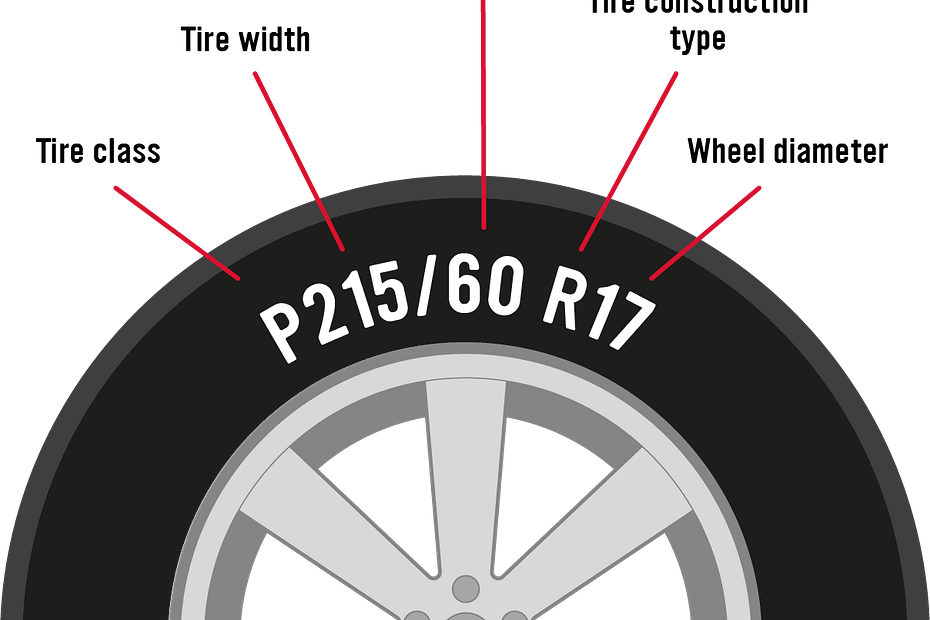Rims come in various sizes, typically ranging from 14 to 24 inches in diameter. The size of the rims is an important factor for ensuring proper fitment and performance of tires on a vehicle.
When selecting the right size rims for your vehicle, it is crucial to consider factors such as the manufacturer’s specifications, the bolt pattern, offset, and width requirements. These specifications can usually be found in your vehicle’s owner’s manual or by consulting with a professional mechanic or tire specialist.
Choosing the correct rim size is vital not only for aesthetic purposes but also for maintaining optimal handling, traction, and overall vehicle performance. Inadequate rim size can affect tire wear, suspension, and even fuel efficiency. Therefore, it is essential to choose rims that are compatible with your vehicle’s specifications to ensure a safe and enjoyable driving experience.

Credit: www.classicspecs.com
Choosing The Right Rim Size
When it comes to upgrading or replacing your vehicle’s rims, choosing the right rim size is essential for both optimal performance and an enhanced overall look. The rim size directly affects the fit and performance of your tires, impacting your vehicle’s handling, ride quality, and fuel efficiency. There are various factors you should consider to ensure you make the right choice. Let’s delve into these factors and explore why tire fit and performance are crucial when selecting the perfect rim size for your vehicle.
Factors To Consider
Tire Fit And Performance
One of the primary factors to consider when choosing the right rim size is tire fit and performance. The rim size must be compatible with the size and specifications of your vehicle’s tires to ensure a proper fit. Proper tire fit is crucial for optimal performance and safety on the road. An ill-fitting rim can cause the tire to wear unevenly and may compromise the handling and stability of your vehicle.
Moreover, the rim size affects the tire’s contact patch with the road surface. A larger rim size allows for a wider tire, resulting in a larger contact patch. This increased contact patch can enhance the traction and grip, especially during cornering and braking. On the other hand, a smaller rim size may result in a narrower tire and reduced contact patch, compromising the tire’s performance in various driving conditions.
Additionally, the rim size plays a vital role in the tire’s sidewall height. A larger rim size generally means a shorter sidewall height, while a smaller rim size results in a taller sidewall. The sidewall height affects the tire’s flexibility, stiffness, and overall ride quality. A shorter sidewall provides a sportier and more responsive handling feel, but it may also transfer more impact and vibrations from the road to the driver. Conversely, a taller sidewall offers a more comfortable ride by absorbing more road irregularities.
Furthermore, selecting the right rim size is also crucial for achieving the correct speedometer and odometer readings. An inaccurate speedometer reading can adversely affect both your safety and adherence to legal speed limits. It’s important to consult your vehicle’s manufacturer guidelines or a trusted tire professional to ensure the rim size doesn’t deviate significantly from the original factory specifications.
In conclusion, choosing the right rim size is critical for tire fit and performance. It directly influences how your vehicle handles, the ride comfort you experience, and the overall performance of your tires. By considering factors such as tire fit, contact patch, sidewall height, and accuracy of speedometer readings, you can find the perfect rim size that not only meets your aesthetic preferences but also enhances your driving experience. Take the time to research and consult professionals to make an informed decision that will improve both the look and performance of your vehicle.
Impact Of Rim Size On Vehicle Dynamics
When it comes to vehicle performance, the size of the rims plays a crucial role in determining its dynamics. The diameter and width of the rims have a direct impact on handling and stability, as well as acceleration and braking. It is important to understand how rim size affects these factors to make an informed decision when choosing the right rims for your vehicle.
Handling And Stability
Rim size has a significant effect on the handling and stability of a vehicle. With larger rim sizes, the tires tend to have shorter sidewalls, resulting in less flex during cornering. This means that the vehicle will respond more quickly to steering inputs and have improved handling capabilities. However, it is important to note that larger rims may also result in a harsher ride and decreased comfort, especially when encountering bumps or potholes on the road.
On the other hand, smaller rim sizes offer increased sidewall height, allowing for more tire flex and a smoother ride. While this may positively impact comfort, it can also lead to a slightly slower response to steering inputs and reduced handling performance. It is essential to strike a balance between comfort and performance when selecting the rim size for your vehicle.
Acceleration And Braking
The size of the rims can also affect acceleration and braking performance. Larger rims are generally heavier due to their increased diameter, resulting in increased rotational inertia. This added weight can negatively impact the acceleration of the vehicle, as it requires more energy to get the rims and tires up to speed. Additionally, larger rims may result in a larger contact patch, which can improve braking performance by providing greater grip and traction on the road surface.
On the other hand, smaller rims are lighter, resulting in reduced rotational inertia. This can positively impact acceleration as less energy is required to get the smaller rims and tires moving. However, the smaller contact patch may lead to slightly diminished braking performance due to less grip and traction.
To summarize, the size of the rims can significantly influence the handling, stability, acceleration, and braking capabilities of a vehicle. It is essential to consider your priorities and the type of driving experience you desire when choosing the right rim size for your vehicle. Consulting with a knowledgeable professional can provide valuable insights and guidance in making this important decision.
Common Rim Sizing Terms
Rim sizing terminology can be confusing for those new to the world of aftermarket wheels. Understanding the common rim sizing terms such as diameter, width, and offset is crucial for selecting the right rims for your vehicle. Let’s take a closer look at each of these terms to help you make an informed decision when it comes to upgrading your vehicle’s wheels.
Diameter
The diameter of a rim refers to the distance between the bead seats on the inside of the wheel. This measurement is typically expressed in inches and can range from 13 to 24 inches for passenger vehicles. Larger diameters are often used for sports cars and trucks, while smaller diameters may be found on compact cars and sedans.
Width
Rim width, measured from one bead seat to the other, plays a significant role in determining the appropriate tire size and overall visual appeal of the vehicle. The width is typically denoted in inches and affects the tire’s contact patch with the road. Wider rims allow for wider tires, providing improved traction and a more aggressive stance, while narrower rims are ideal for narrower tires that prioritize fuel efficiency.
Offset
The offset of a rim refers to the distance between the wheel’s mounting surface and its centerline. This value is crucial in determining the positioning of the wheel within the wheel well. Positive and negative offsets dictate whether the wheel sits closer to the vehicle’s outer or inner fender. Understanding the offset is vital to prevent clearance issues with suspension components or bodywork when installing aftermarket rims.
Customizing Your Rims
When it comes to enhancing the look and performance of your vehicle, customizing your rims can make a significant impact. Whether you are looking to add a touch of style or improve your car’s handling, choosing the right size rims is crucial. Let’s delve into how you can customize your rims for both aesthetic appeal and performance upgrades.
Aesthetic Considerations
- Choose the right rim size based on your vehicle’s make and model
- Consider the design and finish that complements your car’s overall look
- Opt for custom colors or patterns to make a bold statement
Performance Upgrades
- Upgrading to larger rims can enhance your car’s handling and cornering abilities
- Selecting lightweight rims can improve acceleration and fuel efficiency
- Consider rim material like alloy or carbon fiber for durability and performance
Maintenance And Care For Rims
Keeping your rims in top condition is essential for both the performance and aesthetics of your vehicle. Routine maintenance and care for rims not only prolong their lifespan but also ensure a safe driving experience. By following some simple cleaning tips and practices, you can prevent damage and keep your rims looking like new for longer.
Cleaning Tips
- Use a gentle, non-abrasive cleaner to remove dirt and grime from your rims.
- Regularly wash your rims with soap and water to prevent build-up of debris.
- Invest in a soft-bristled brush to reach into crevices and remove stubborn dirt.
- Dry your rims thoroughly after cleaning to avoid water spots and corrosion.
Preventing Damage
- Avoid using harsh chemicals or abrasive materials that can scratch or damage your rims.
- Inspect your rims regularly for any signs of wear, cracks, or bending.
- Consider using protective coatings or sealants to add an extra layer of defense against corrosion.
- Be cautious when driving over potholes or rough terrain to prevent impact damage.

Credit: www.tirebuyer.com

Credit: www.atv.com
Frequently Asked Questions For What Size Rims
How Do I Know What Size Rims To Get?
To determine the right rim size, check your vehicle’s manual or the current rim’s specifications. Consult with a professional if unsure. Additionally, consider the desired tire size and vehicle specifications for compatibility.
How Do You Match Tire Size To Rim Size?
To match tire size to rim size, ensure the tire’s width and diameter correspond with the rim’s specifications. Check the tire’s sidewall markings for these measurements, expressed in millimeters and inches. Consulting a tire size chart can help determine compatible combinations to ensure proper fitment and performance.
Can I Replace 16 Inch Wheels With 18 Inch?
Yes, you can replace 16 inch wheels with 18 inch ones. However, it is important to consider potential impact on the overall performance of the vehicle, including speedometer accuracy, tire clearance, and suspension compatibility. It is recommended to consult with a professional to ensure proper fit and compatibility.
Should Rim Size Be Same As Tire Size?
Yes, the rim size should match the tire size for proper fit and function. The two sizes work together to ensure safe and efficient vehicle operation. Mismatched sizes can lead to handling issues and compromise safety. Always consult the manufacturer’s recommendations for the correct tire and rim sizes.
Conclusion
Choosing the right rim size for your vehicle is a crucial decision that affects both the aesthetics and performance of your car. By considering factors such as safety, handling, and style, you can make an informed choice that enhances your driving experience.
Remember to consult with experts and consider your driving needs before making a decision.
